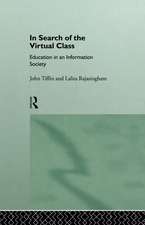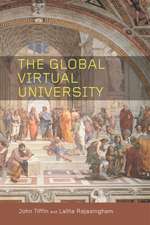HyperReality: Paradigm for the Third Millenium
Editat de Nobuyoshi Terashima, John Tiffinen Limba Engleză Hardback – 18 oct 2001
What comes after the Internet? Imagine a world where it is difficult to tell if the person standing next to you is real or a virtual reality, and whether they have human intelligence or artificial intelligence; a world where people can appear to be anything they want to be. HyperReality makes this possible.
HyperReality offers a window into the world of the future, an interface between the natural and artificial. Nobuyoshi Terashima led the team that developed the prototype for HyperReality at Japan's ATT laboratories. John Tiffin studied they way HyperReality would create a new communications paradigm. Together with a stellar list of contributors from around the globe who are engaged in researching different aspects of HyperReality, they offer the first account of this extraordinary technology and its implications.
This fascinating book explores the defining features of HyperReality: what it is, how it works and how it could become to the information society what mass media was to the industrial society. It describes ongoing research into areas such as the design of virtual worlds and virtual humans, and the role of intelligent agents. It looks at applications and ways in which HyperReality may impact on fields such as translation, medicine, education, entertainment and leisure. What are its implications for lifestyles and work, for women and the elderly: Will we grow to prefer the virtual worlds we create to the physical world we adapt to?
HyperReality at the beginning of the third millennium is like steam power at the beginning of the nineteenth century and radio at the start of the twentieth century, an idea that has been shown to work but has yet to be applied. This book is for anyone concerned about the future and the effects of technology on our lives.
| Toate formatele și edițiile | Preț | Express |
|---|---|---|
| Paperback (1) | 140.10 lei 6-8 săpt. | |
| Taylor & Francis – 4 oct 2001 | 140.10 lei 6-8 săpt. | |
| Hardback (1) | 372.15 lei 6-8 săpt. | |
| Taylor & Francis – 18 oct 2001 | 372.15 lei 6-8 săpt. |
Preț: 372.15 lei
Nou
Puncte Express: 558
Preț estimativ în valută:
71.21€ • 74.36$ • 58.80£
71.21€ • 74.36$ • 58.80£
Carte tipărită la comandă
Livrare economică 15-29 aprilie
Preluare comenzi: 021 569.72.76
Specificații
ISBN-13: 9780415261036
ISBN-10: 0415261031
Pagini: 182
Ilustrații: Illustrations
Dimensiuni: 156 x 234 x 14 mm
Greutate: 0.51 kg
Ediția:1
Editura: Taylor & Francis
Colecția Routledge
Locul publicării:Oxford, United Kingdom
ISBN-10: 0415261031
Pagini: 182
Ilustrații: Illustrations
Dimensiuni: 156 x 234 x 14 mm
Greutate: 0.51 kg
Ediția:1
Editura: Taylor & Francis
Colecția Routledge
Locul publicării:Oxford, United Kingdom
Public țintă
Postgraduate and UndergraduateCuprins
List of figures List of contributors Preface Acknowledgements Introduction John Tiffin
Part 1 Technology: 1. The Definition of HyperReality Nobuyoshi Terashima 2. The HyperReality Paradigm John Tiffin 3. HyperVision Narendra Ahuja and Sanghoon Sull 4. Virtual Humans Nadia Magnenat-Thalmann, Prem Kalra, Laurent Moccozet 5. Artificial Life in HyperReality Katsunori Shimohara
Part 2 Applications: 6. HyperTranslation Minako O'Hagan 7. The HyperClass John Tiffin and Lalita Rajasingham 8. HyperLeisure John Tiffin 9. HyperMillennium John Tiffin and Nobuyoshi Terashima Index
Part 1 Technology: 1. The Definition of HyperReality Nobuyoshi Terashima 2. The HyperReality Paradigm John Tiffin 3. HyperVision Narendra Ahuja and Sanghoon Sull 4. Virtual Humans Nadia Magnenat-Thalmann, Prem Kalra, Laurent Moccozet 5. Artificial Life in HyperReality Katsunori Shimohara
Part 2 Applications: 6. HyperTranslation Minako O'Hagan 7. The HyperClass John Tiffin and Lalita Rajasingham 8. HyperLeisure John Tiffin 9. HyperMillennium John Tiffin and Nobuyoshi Terashima Index
Notă biografică
John Tiffin is Professor Emeritus of Communication Studies at Victoria University of Wellington and Chancellor and founder of the Global Virtual University. Nobuyoshi Terashima is the Dean of the Graduate School of Global Information and Telecommunication Studies at Waseda University, Japan.
Descriere
Explores the defining features of HyperReality: what it is, how it works and how it could become to the information society what mass media was to the industrial society.















